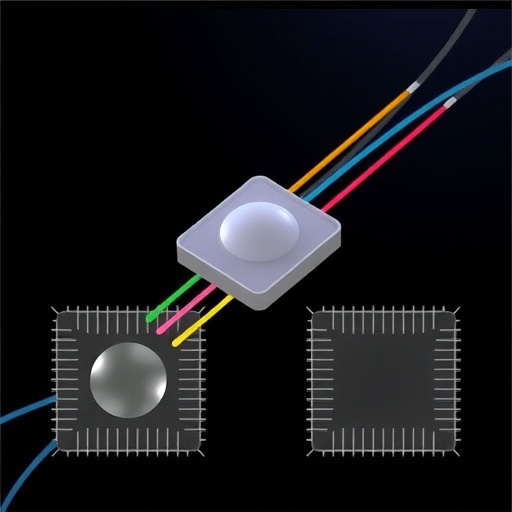Recent advancements in bioelectronics are paving the way for the development of sophisticated implantable devices that can interface seamlessly with the human body. Central to this evolution is the introduction of skin-like transistors, which exhibit exceptional mechanical properties that mirror human tissue. These innovative devices are not merely theoretical constructs; they are being actively developed and tested within living organisms, showcasing robust functionality and stability under varied physiological conditions. The implications of this technology are profound, hinting at a future filled with possibilities for real-time health monitoring and intelligent therapeutic strategies.
One of the primary innovations of these skin-like transistors is their ability to perform logic functions essential for computational operations in bioelectronic systems. In a series of experiments detailed in recent research, various logic circuits such as inverters, NOR gates, and NAND gates were fabricated using these transistors. These fundamental building blocks are integral for constructing complex bioelectronic applications capable of sophisticated signal processing in medical scenarios. The versatility of these circuits is underscored by their successful implementation in a real-world context, where they were implanted subcutaneously in laboratory mice.
The schematic representations of these circuits reveal an intricate design aimed at enduring the mechanical strains typical of biological tissues. This aspect is particularly important because the physical demands placed on implantable devices can often lead to failure. However, the pseudo-complementary-metal-oxide-semiconductor (CMOS)-based logic circuits demonstrated resilience, maintaining stable electrical performance even when subjected to significant mechanical stretching.
A closer look at the performance metrics of the implanted devices offers compelling insights into their capabilities. The inverter circuit, for instance, displayed notable voltage transfer characteristics, maintaining operational stability under 50% strain throughout a three-day monitoring period. This consistent performance is not merely a technical achievement but also a critical factor for any bioelectronic device aimed at practical applications, particularly in environments as variable as the human body.
In addition to the inverters, the NOR and NAND gates exhibited similarly stable outputs, confirming their reliability even with mechanical deformation. This stability is paramount as it assures ongoing functionality in practical applications where electronic circuits must withstand the rigors of physiological movements. The experiments further highlighted that the gain of these inverters remained unchanged post-implantation, suggesting a promising avenue for future applications.
As the study unfolded, it became crucial to assess the biocompatibility of these transistors within a living organism. This investigation included the analysis of inflammatory markers and histological evaluations of the implantation site, which provided essential data regarding the body’s immune response to the foreign device. The findings indicate a minimal inflammatory response, similar to that observed in sham-operated groups, underscoring the possibility of integrating these circuits into human applications without inducing significant immune overreactions.
Particularly noteworthy was the lack of immune cell infiltration at the implantation site, reinforcing the potential for the use of these devices in long-term applications. The absence of such infiltration points to a smooth integration within the biological environment, a critical requirement for devices intended for chronic use. The research not only highlights the immediate functionality of the devices but also establishes their viability for future clinical scenarios.
The overall results emphasize the efficacy of these skin-like transistors in terms of performance, stability, and biocompatibility, suggesting a strong foundation for their application in advanced bioelectronics. The implications extend towards various medical fields, including real-time monitoring of physiological parameters, advanced neural interfacing, and even the potential for closed-loop therapeutic interventions that respond autonomously to physiological changes.
From a technological perspective, the development of these bioelectronic devices promises a notable shift in how we approach healthcare and body monitoring in the future. The inherent soft and stretchable nature of the materials allows for seamless integration with biological tissues, reducing the likelihood of complications that arise from mechanical mismatch. This innovation not only enhances patient comfort but also significantly mitigates the risks associated with chronic inflammation and fibrosis.
In conclusion, the skin-like transistors represent a groundbreaking step towards advanced biomedical devices that can closely interface with human physiology. Their multifunctionality, coupled with a robust performance in real-world biological settings, opens new avenues for innovation in medical technology. As researchers continue to refine these technologies, the horizon of possibilities alluding to enhanced healthcare monitoring and therapeutic interventions expands substantially.
These skin-like circuits are not just a technological novelty; they are emblematic of a future where electronics and biological systems seamlessly merge. With ongoing research and development, we stand at the cusp of potentially transformative health care solutions that could redefine the landscape of personal and clinical medicine.
Subject of Research: Development of Skin-Like Transistors for Implantable Bioelectronics
Article Title: A biocompatible elastomeric organic transistor for implantable electronics.
Article References:
Jung, K.H., Hyun, J., Jeong, M.W. et al. A biocompatible elastomeric organic transistor for implantable electronics.
Nat Electron 8, 831–843 (2025). https://doi.org/10.1038/s41928-025-01444-9
Image Credits: AI Generated
DOI: https://doi.org/10.1038/s41928-025-01444-9
Keywords: Bioelectronics, Skin-like Transistors, Implantable Devices, Biocompatibility, Logic Circuits, Physiological Monitoring, Neural Interfacing.
Tags: biocompatible elastomeric transistorsbioelectronics research and developmentimplantable bioelectronic devicesinnovative medical technologiesintelligent therapeutic strategieslogic circuits in bioelectronicsmechanical properties of bioelectronicsphysiological stability of implantsreal-time health monitoringsignal processing in medical applicationsskin-like transistors technologysubcutaneous implantable devices





